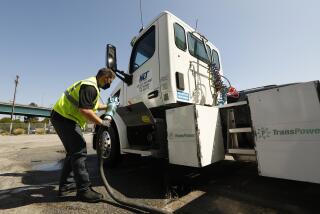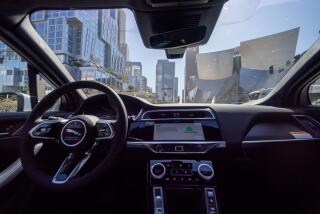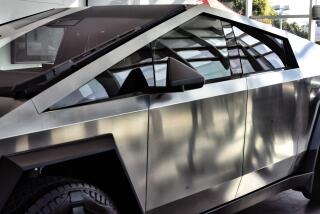A Small World : Mini-Truckers Say They’re Just Cruising for a Good Time--Not Trouble
At last Sunday’s meeting of Blind Vision at a Westlake Village park, members of the mini-truck club staged an impromptu contest to see whose truck was the lowest.
The winner was a Mazda owned by David Terranova, 20, of Simi Valley, whose truck was 2 3/16 inches off the asphalt at its lowest point.
Terranova said he removed two leaves from the truck’s springs, removed a ride-cushioning item called stoppers and installed undersize tires and rims.
“I got one ticket for being too low,” he said. “I think the cop noticed because my mud flaps were scraping when I passed him.”
Lowering is the latest fad among mini-truckers--the ‘80s version of 1950s hot rodders. Mini-truckers spend thousands of dollars on custom work to distinguish their light, imported trucks from those used only for hauling.
By effecting these changes their owners earn entry into clubs like Blind Vision. They also sometimes earn bad reputations.
When a crowd of more than 200 young people rioted outside a Burger King in Simi Valley one recent weekend, a worker at the restaurant blamed the brawl in part on “the mini-truck brigade.”
“No one in my group was even there,” complained Glenn Yamashiro, president of the Simi Valley chapter of Blind Vision.
“Because we cruise around in numbers, people think we cause trouble. But it’s just more fun that way. The problem was with outsiders, just like always.”
Outsiders Blamed
Lt. Rick TerBorch of the Simi Valley Police blamed youths from outside Simi Valley for starting the June 28 riot, which included several fights and damage to several cars. Police reported that it took eight officers and a police dog about 15 minutes to end the brawl and disperse the crowd. One officer received minor injuries and one arrest was made.
“Because there’s more of us and we stand out, they blame it on us,” said Scott Osborn, 20, president of the Conejo Valley chapter of Blind Vision.
“People associate clubs with gangs. But we know the difficulty of finding a place to hang out and cruise. When we find a place, we like to keep it mellow.”
Police spokesmen in the San Fernando, Conejo and Santa Clarita valleys said that mini-truckers do not present more than their share of crime problems. No figures are available on their numbers.
Generally Not a Problem
“There’s a certain amount of alcohol consumed and that’s a concern to us,” TerBorch said of local weekend gatherings like the one outside Burger King. “But, except for clogging up parking lots, they generally aren’t a problem.”
Registration of light trucks in Los Angeles County has boomed in recent years, growing from 73,033 in 1984 to 134,522 last year, according to the Torrance-based research firm R.L. Polk & Co. Many of the owners band together in clubs, 140 such groups making up the Southern California Mini-Truck Council.
Yamashiro, 23, said that Blind Vision’s chapters in the Simi and Conejo valleys have about 30 members. There are six to eight other clubs in the area, he estimated, adding that “for every guy in a club, there’s an independent who likes to cruise but doesn’t want to join a group.”
“The problem is that there’s just too many kids,” he said. “Simi Valley’s growing. Everywhere is growing. School’s out, and there are a lot of kids around. We’d draw 600 people at the lot on Tapo before we got kicked out. Then we played musical lots, getting kicked out of one after another.
“We’re not asking for anything more than the adults had when they were young. Now it’s our era, and everything’s getting closed down. Angelo’s in Anaheim is probably the greatest cruise spot of all time. My dad cruised Angelo’s. It closed this year. Van Nuys Boulevard, Westwood, Foothill Boulevard in Tujunga--they’re all closed down.”
Yamashiro does his cruising in a red 1987 Mazda. It is his second truck. The first was stolen and never recovered.
“When I got my new one, I said I’d keep it stock,” he remembered. “I said that’s better, because if Mazda thought it would run better lowered, they’d have sold it lowered. But, within two weeks, I was fixing it up. I don’t like to drive the same thing as everyone else.”
He said his girlfriend’s mother recently bought a new blue Nissan Maxima.
“She always asks me why I don’t use my money to buy something nice, a family car or a sedan,” he said. “Well, one day she went out into a parking lot and there were two other Maximas, just like hers. She had to look at the license plate to see which one was the right one. I’d hate that. I want something that stands out.”
Yamashiro’s improvements to the Mazda include cutting off the top to turn the vehicle into a convertible.
“My insurance company said they’d cancel me if I did it,” he said, “so I’m taking my chances.”
He has electric doors that open by pushing a button near the grill. And, of course, the truck is lowered.
There are two California Vehicle Code sections covering lowered vehicles, said Officer Mark Stone of the California Highway Patrol’s West Valley office. One makes it illegal for the center of a headlamp to be less than 24 inches above the ground. The other states that no part of the vehicle may be any lower than the lowest part the tire rim.
Blind Vision members had several stories about the misadventures of a lowered truck. One member said a piece of cardboard was trapped by the undercarriage and dragged along until it caught fire. Another said he cannot drive over a bottle without breaking it.
Steve Kramer, owner of California Mini-Trucks in Van Nuys, has been in on the small-truck boom almost from the start. The store sells and installs mini-truck parts.
“We opened eight years ago in Van Nuys,” Kramer said. “Now we’ve got a store in Anaheim and a worldwide mail-order business. The light truck market still is going no place but up.”
Kramer described his average customer as a male student 16 to 25 years old.
Like many others in the field, Kramer believes that cost is the big reason for the mini-truck craze among young people.
“Base price on a Japanese two-wheel drive is $6,000,” he said. “You can buy some tires and rims for $600 or $700 and lower it, and you’re there for under a thousand bucks. You’re part of the in crowd. Of course some idiots have spent as much as $25,000 on these things.”
Kramer readily acknowledges that he has developed an “attitude” from dealing with a class of truck owner he terms “the guys with eyeballs spinning around in their heads from smoking dope.”
“You’re talking about people with six-word vocabularies,” Kramer said. “You’ve got some real strange mentalities. There are mini-truckers and there are people who own mini-trucks, just like there are murderers and there are people who own guns.”
Blind Vision’s Yamashiro, who works for an asbestos abatement company, said he often encounters the stereotype of the spaced-out mini-trucker.
“People seem to think we’re kids with no jobs and nothing to do but drive around in our trucks. But we work. What we do with our trucks carries a lot of motivation behind it. These guys take real pride in their vehicles.”
He said, however, that some action should be taken to prevent incidents such as the riot outside the Burger King.
“Face it, this is Simi Valley and there’s nothing to do. The kids just want a place to socialize.”
A delegation of mini-truckers has met with police, city officials and other community leaders in the effort to find a place for youth to gather on weekend nights. An informal committee has formed to explore such problems as providing liability insurance and keeping outsiders away.
TerBorch said an effort is under way to find a large parking lot where local young people can gather on weekends. Ideally, he said, security guards or some other supervisory unit would be on hand to admit only local vehicles.
Representing the Simi Valley Chamber of Commerce on the committee is Andy Macek, owner of a local tool company. He worries that youth tension is building.
“I think it’s going to get worse because, as the kids get more affluent, they have their cars but no place to go,” Macek said. “They want something to do.”
More to Read
Sign up for Essential California
The most important California stories and recommendations in your inbox every morning.
You may occasionally receive promotional content from the Los Angeles Times.










